The story of S/S Germanic, or Turkey’s precious “S/S Gülcemal”
There are so many things that differ ships from any other vehicle, so many things that makes us feel they have soul. Ships have a longer life span and they witness much more. They become a part in peoples lives, a part of history. This time i’ll try to tell the story of S/S Gülcemal, the only transatlantic of Turkey.

in 1874 Harland and Wolff shipyard launched another liner for the White Star Line. Her initial name was Hellenic but then changed to Britannic. She was the first ship to carry this name along with the two following ships with the same name. The second Britanic was the sister of RMS Titanic. The same year, her sister was launched but competed in 1875. The name seen on the freeboard was “Germanic”. The sisters were 139 meters long 13.77 meters wide. They had 4 masts equipped with sails. Double funnel raising between the masts gave them sexy look. These stacks were fed by 8 boilers. Germanic was built with two 2 cylinder compound engines but in 1895 they were replaced by triple-expansion engine built by Maudslay Sons & Field. The square sail rigging was also removed in this renovation and the funnels were raised. And she had a huge propeller with a radius of 7 meters which is referred as a state of the art in Turkish sources. This propeller steamed the ship over 15 knots with 52 revolutions per minute and burning 85 tons of coal a day. The ships had a capacity of 1720 passengers. 220 1st class, 1500 3rd class.
Two sisters began their transatlantic service and soon, in 1876 Britannic got the blue riband for both eastbound and west bound atlantic crossing. But she lost the eastbound blue riband to her sister Germanic in February 1876. Germanic also beat her own record once . The average speed was around 16 knots.

Mehmet Ubeydullah Hatipoğlu (Ubeydullah Efendi), a Turkish writer and politician sailed onboard Germanic in 1893 from Liverpool to NewYork (Probably) and he wrote some information about the ship. He mentioned that there was a library on the promenade deck and a table was hung on the wall of the library every morning at 9 which showed the current position and the distance covered. He wrote that there was a piano and a big mirror in the fore side of dining room, there was a small garden on the ship where the fresh flowers on dining tables were grown. Everynight there was a concert he says.
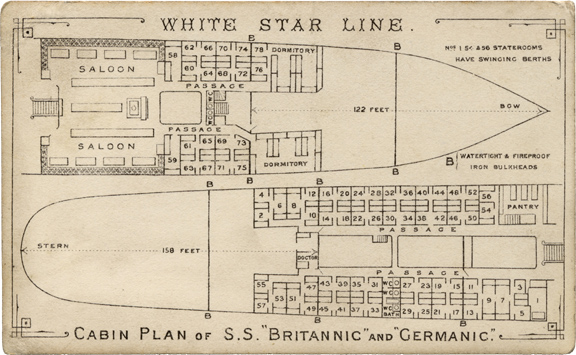
In 1899, while Germanic was coaling at White Star line pier in NewYork, a storm covered her decks with heavy snow and ice. She became top heavy and listed to port side, and water rushed in from open doors. She sattled on shallow harbour ground.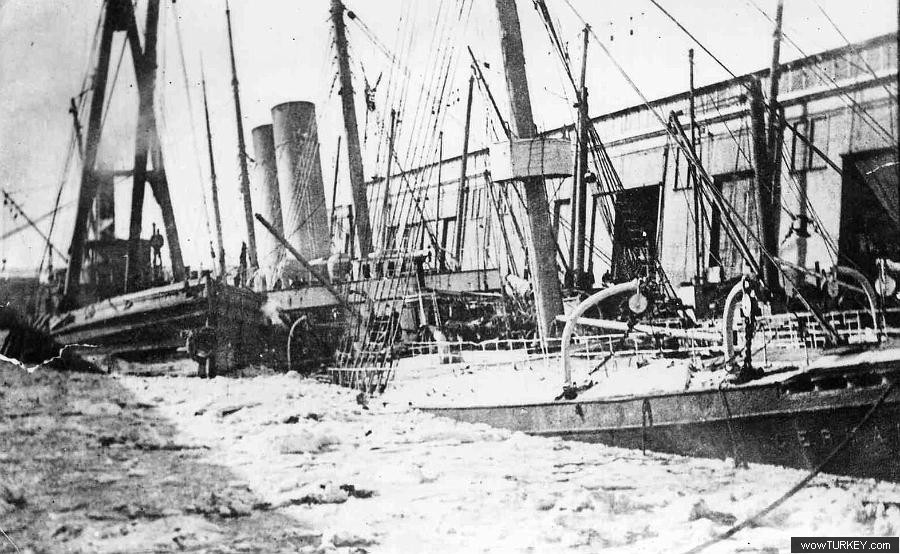
Then she was raised and went to Belfast for repairs which took four months.
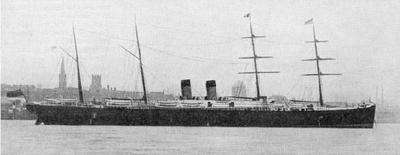
In 1903 she was sold to American line and served between Southampton and Newyork. Then in 1905 she was sold to Dominion Line and renamed as “Ottawa”. Dominion line was serving for immigrant trade. In 1909 she was laid up.
In 1910, Ottoman government bought the ship with 25.110.60 golden liras and she was renamed “Gülcemal” . But the company was ran by French and at that time Arabic alphabet was in use. So the name of the ship was recorded as “Gul Djemal” This was to be fixed back to Gülcemal later. The name Gülcemal was Sultan 5th Mehmet Reşat’s mother’s name which meant “beautiful as a rose”.
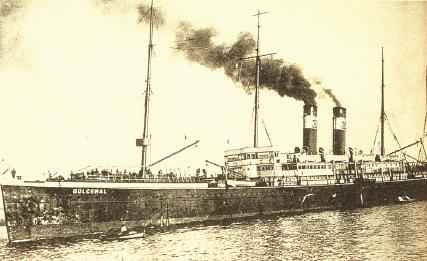
The ship was renewed while still in England. The furniture, dining accesories, kitchens and so on… And she was drydocked in Germany once and had a comprehensive restoration. In the frst years she carried Turkish soldiers to Yemen. At the end of Balkanian war, the soldiers were taken back onboard. She carried haji’s to Jeddah and back.
 During the WW1, she served as a hospital ship for a while and then she carried soldiers to Gelibolu (Galipolli) peninsula. In one trip she was torpedoed by English submarine E14 which could penetrate from Dardanelles straight under water to Sea of Marmara. Gülcemal was wounded from her bow. Some soldiers panicked and juped over board thinking that she will sink. And some of them drawned cause they did not know how to swim. The rest were carried to land by bosphorus steamer “Kalender” and car ferry “Sahilbent”. Then she was towed to Istanbul to be fixed, which took two years. At the end of the war, in 1918-19 she carried German prisoners kept in Egypt and Greece back home to Hamburg and Wilhelmhaven. Sunay Akın, a Turkish poet and researcher mentiones that Gülcemal broke another speed record during these voyages. She also served between thessalonica and Alexandria.
During the WW1, she served as a hospital ship for a while and then she carried soldiers to Gelibolu (Galipolli) peninsula. In one trip she was torpedoed by English submarine E14 which could penetrate from Dardanelles straight under water to Sea of Marmara. Gülcemal was wounded from her bow. Some soldiers panicked and juped over board thinking that she will sink. And some of them drawned cause they did not know how to swim. The rest were carried to land by bosphorus steamer “Kalender” and car ferry “Sahilbent”. Then she was towed to Istanbul to be fixed, which took two years. At the end of the war, in 1918-19 she carried German prisoners kept in Egypt and Greece back home to Hamburg and Wilhelmhaven. Sunay Akın, a Turkish poet and researcher mentiones that Gülcemal broke another speed record during these voyages. She also served between thessalonica and Alexandria.
Gülcemal is the first Turkish flagged ship ever sailed to America. Before her, in 1864 Bursa and İzmir corvettes left İstanbul but lost their ways in Atlantic and drifted to Brasil. Then they came back sailing around Africa. Gülcemal was hired by a Greek business man Jorj Dedeoğlu under Ottoman-American Line to carry immigrants by the route Constanta-Istanbul-Napoli-Marseilles . She arrived NewYork October 31st of 1920 once again after serving in other waters for a long while. The event took a large place in Turkish newspapers. New York Tribune also gave a place to the ship. Turkish, Greek and Armenian people in New York rushed to the ship to see the crew and the passengers. Also Americans had some interest to the ship, it appears that they were surprised to see a steam ship with a Turkish crew. Gülcemal made a total of 4 voyages to America. The last was in 1921.
Later, in the first years of Republic of Turkey, she sailed on Mediterranean, Aegean and Blacksea routes. She had a very special place in Turkish people’s hearts. Especially in Blacksea shore, she was a legend. She can be found in folk songs and poetry. She was leaving Istanbul and stopping by every importent port, transferring passengers and cargo all the way to eastern Blacksea. Then coming back the same way. This was slowing the ship down ofcourse. So it took a place in Blacksea as a saying: “Don’t stop by everywhere like Gülcemal. Be quick”.
Mustafa Kemal Atatürk also sailed on Gülcemal for a few times and he wrote to ship’s journal how well prepared the crew was and thanked.
Gülcemal was also a part of population exchange between Turkey and Grece. Lots of people had to leave their homes according to the deal between Greek and Turkish governments. This was a very sad event and the social effects took a lot of time. Gülcemal is a sad memory in many Turkish Greek, and Greek Turk families. Think about two nations sharing the same sea, having the same food, having so similar cultures and you are taking these apart…

People on Gülcemal’s deck, one of the voyages between Greece and Turkey population exchange.
Gülcemal was navigated by a young but highly skilled and respected captain, nicknamed “Topuz” (war club) Lütfi Kaptan. Every captain has a relationship with his ship, but Lütfi Kaptan’s bond with Gülcemal was a different one. He was given a present, some paint to paint his house but he took it to Gülcemal to paint the ship. Unfortunately he died very early at the age of 46. The silver cigar box left to his daughter from him was a present from Trotsky.
Gülcemal was taken out of regular service in 1937. Her name was in international Lloyd records in 1945 for the last time. She was being used as a storage ship in 1949. In 1950, there were rumours that she was going to become a hotel ship but in never happened. In late 1950, she was towed to Messina by an offshore tug, and scrapped. When she sent to scrap in 1950, she had her place in history as the second longest serving ship in the world with 75 years.
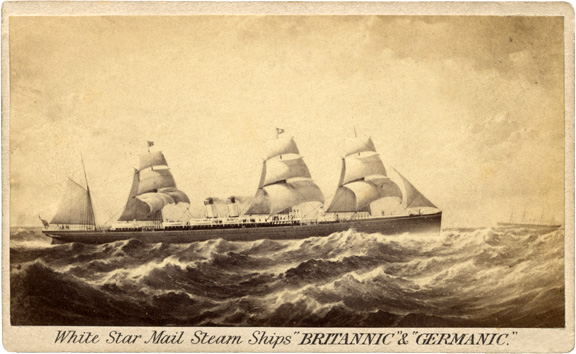


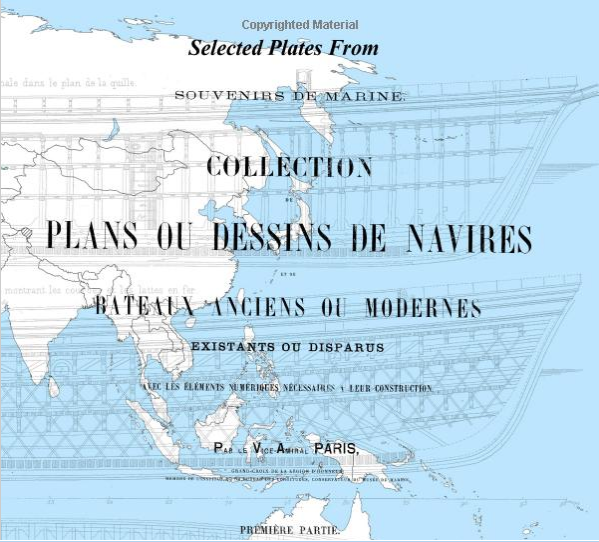










The best narration ever for “S/S Gülcemal” on the web!
Congratulations!!!